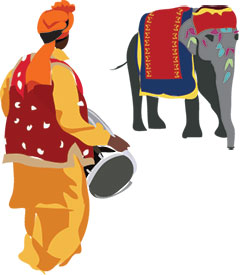For Manil Suri, Math + Fiction + Ambition = A Career > The Sum of Its Parts
by Mark Athitakis
Last October, UMBC professor of mathematics Manil Suri planned to end a session of his Introduction to Numerical Analysis class with a short video presentation he had created called Pride and Prejudice on the Complex Plane.
The class is a 400-level course on complex matters like fixed-point iteration, Taylor series, and the mean value theorem. But Pride and Prejudice on the Complex Plane is breezy six-minute PowerPoint riff on imaginary numbers (such as the square root of -2). The presentation is styled as a pro-diversity PSA that cautions, in a tongue-in-cheek way, the barbarians who think imaginary and real numbers ought to exist in separate spheres. (The opening slides say the video is presented by “The Coalition for Digital Dignity” and the “Numerical Rights Campaign Fund.”)
Suri intends to include Pride and Prejudice, and other animations like it, in an interactive novel he’s writing. “I’ve been working on this for a long time now, trying to come up with a book for non-mathematicians on math,” he says. He adds, though it goes without saying: “It’s very difficult.”
A good storyteller might be able to pull it off, and Suri is a widely acclaimed one. The Death of Vishnu, his 2001 debut novel, was a moving chronicle of the day in the life of the residents of a Mumbai apartment building. The book earned a PEN/Robert W. Bingham Prize, given annually to the best first works of American fiction, and it was a finalist for the prestigious PEN/Faulkner Award. His follow-up novel, 2007’s The Age of Shiva, was a more expansive work about Suri’s native India after partition; it became a bestseller that the New Yorker (the first place his fiction appeared) called “a sensuous, nuanced portrait of motherhood.”
Suri has taught math at UMBC since 1983, and his CV is rich with accomplishments in that field as well. So in recent years he’s attempted to merge his dual passions in presentations, in papers, in coursework, and in videos like Pride and Prejudice on the Complex Plane. But it’s a struggle.
“I feel like I’ve got a platform in some sense, afforded by whatever success I’ve had as an author – people might say, ‘I’ve read a book by him, let me try this,’” observes Suri. “The only problem with that is, now that this is going to be a novel, I keep fighting. How much math should be in there? Is this really necessary for the story?… Even these videos, I have to look at them really carefully. Are they really stories, or am I just giving a math lecture? The second is not going to be as popular.”
That day in Introduction to Numerical Analysis, Suri had precisely the opposite problem. The 20 students in the room came ready with a host of questions in advance of a test, and there was no time for the video. You have to wonder, as Suri does: What’s the best way for math and storytelling to get along?
UNDER WRAPS
As it happens, there’s a bit of math in Suri’s third novel, The City of Devi, which is set in the near future and centers on Sarita, who loses track of her fiancé when a series of apocalyptic events – cyberattacks, blackouts, religious riots – strikes Mumbai. Sarita is a statistician whose beloved, Karun, was an anxious lover, and her diary entries assign star ratings to the couple’s early bedroom interactions. “Our performance had a weekly mean of 4.35 stars over the past five months or so, with a standard deviation of 2.72,” Suri writes.
It’s not Nabokov, but it’s not meant to be: The City of Devi is a broader and (despite its opening calamities) funnier novel than its predecessors, exploring hive mentalities, conventional wisdom about relationships, and cults of personality. That its heroine is a statistician – and not a mathematician, as Suri kept reminding his publisher – was a complicated decision. “I agonized over that, because you find so few statisticians in literature, or math-type people,” he says.
Indeed, the shelf of books of math-related fiction, or books by mathematically trained fiction writers, is a short one. Alice in Wonderland author Lewis Carroll taught math at Oxford. Edwin Abbott’s 1884 novel Flatland leveraged geometry to satirize Victorian society. Mark Haddon and Richard Powers have integrated math-based puzzles into their work. David Foster Wallace wrote a book on infinity, 2003’s Everything and More, though many mathematicians found his analytical chops wanting. (“I think he was just showing off too much,” Suri says.)
For a long time, Suri was conflicted about joining those ranks. When he began writing fiction in earnest in the mid-’90s, he kept it a secret among his academic colleagues. As he was finishing The Death of Vishnu, he was collaborating with Panos G. Charalambides, a professor in UMBC’s department of mechanical engineering, on methods to analyze materials called “woven composites” for stress and distortion. Suri’s collaborations with other researchers on analysis of structures and materials have been widely cited and have been used in software tools, but Charalambides says that he hadn’t the slightest idea about Suri’s novel as they worked together.
“Once I learned, I was tickled pink,” Charalambides says. “Often enough, scientists are unitary. There’s a stereotype that they don’t have other interests. And clearly Suri has tremendous interests.”
Tremendous interests can be tricky in the sciences, though, and the pervasiveness of that stereotype prompted Suri to keep quiet about his sideline. Early in his teaching career he was told that great mathematicians focus exclusively on math; he once heard a speaker dismissed by colleagues for being a good bridge player. “That made me realize that if I’m doing this writing, maybe it’s a good idea to keep it under wraps, at least until I get tenure,” he says.
By the time he received tenure in 1989, not talking about his fiction had become a habit. And besides, a fiction writer’s path to success is hard to explain. Suri describes his own experience as pure luck: He had the support of writing teachers like Richard McCann, Michael Cunningham, and Vikram Chandra, and a writing retreat at the MacDowell Colony introduced him to an agent and publisher who admired and supported The Death of Vishnu.
“Anywhere along the way, if that chain had broken, it could have been a long time before I’d be able to get to that stage,” observes Suri.
UNCOMMON GROUND
In the fall of 2011, Suri collaborated with Michele Osherow, an associate professor in the Department of English, to teach a freshman humanities seminar at UMBC. Osherow is also resident dramaturg at the Folger Theatre in Washington, DC, and she first worked with Suri in 2009, when she asked him to help her and the actors understand the math in a production of Tom Stoppard’s play Arcadia. She recalls, however, that she was initially intimidated about approaching him to consult on the play. “Maybe it’s something about the way our culture now and historically represents mathematicians as these brilliant but crazy people,” Osherow says.
The course they taught together (“Mathematics and What It Means to Be Human”) addressed some of those stereotypes as they emerged in movies like Good Will Hunting and Pi. Their syllabus strived to connect their disciplines: King Lear allowed the class to discuss zero as a concept; the fiction of Jorge Luis Borges was an avenue for students to ponder infinity.
But common ground eluded the two professors. In a three-part series published last fall in The Chronicle of Higher Education, the tandem described how often they split philosophically. “We sort of found a groove, but it took us a while to realize that we were never actually going to see things in the same way,” Osherow says. “Instead of trying to solve that problem, there came a point where we just sort of cherished it.”
For instance, Suri was frustrated with the way poets like Archibald MacLeish and J.V. Cunningham would casually – and, to his mind, imprecisely – use mathematical terms in their work. “We would argue about what precision was, and the word precise,” Osherow says. “We would argue about the purpose of poetry.”
Suri stresses that he enjoyed the experience, and embraced the loggerheads at which he and Osherow often found themselves. But he also understood how students were frustrated with a seminar that couldn’t cleanly connect math and literature. “We all like to learn things we already know or are comfortable with,” he says. “So what happens with these classes is that the expectations are much harder to pin down.”
It may be that the connection is impossible, an oil-and-water proposition. In the 1920s, Soviet scholar Vladimir Propp identified the structural elements of folklore and fairy tales, and in the ’60s, a French group of writers championed Oulipo, a method that applies rigorous constraints on creative writing. Suri has found such devices useless in his own fiction, though. When he first began work on The City of Devi in 2001, he devised a series of decision trees for his characters, but “the only solutions were the most trite things you can think of,” he says, adding a joke: “I was actually quite happy because I found a mathematical proof that this novel could not be written.” Nearly a decade later, such schemes abandoned, he found a way back in.
But if Suri can’t quite blend math and fiction, he also can’t pursue only one of his two main interests. When he received a Guggenheim Fellowship in 2004, he took a year off to work at home on his next novel. (He lives in Silver Spring with his partner, Larry Cole.) But he missed teaching. “When I used to be a student, and when I was beginning faculty member, I always felt that there was a gap I had to fill with creative writing or something else,” he says. “And now when I was spending all that time doing creative work, it was more like I need to do something completely logical and mathematical. There was that gap that needed to be filled.”
FINDING A SOLUTION
Pride and Prejudice on the Complex Plane is one of two videos Suri has sketched out so far for his e-book project. A second, The Bitter Tears of Petra Von Fraction, is a seriocomic take on irrational numbers like pi and e. The star of that presentation is a woman who can make herself into any integer-based fraction yet who dreams of being the square root of two. Her “journey of self-discovery” leads to the “terrible surprise” that there’s no way to render the square root of two as a clear, integer-based fraction.
Suri concludes the tale thusly: “Petra assumed forms that brought her closer and closer to her beloved, and with each step she took, with each digit she added, Petra shed another bitter tear.”
So are Suri’s Pride and Prejudice and Petra Von Fraction stories? Clever teaching aids? The first steps of the Proppian folktale morphology? Anthropomorphizing numbers, even irrational ones, has a way of being unsatisfying in the traditional literary sense. Suri recognizes that it’s not there yet, but he’s persistent. “I need to somehow make this work,” he says. “Somehow there’s an opportunity there, which can be synergistic in some way.”
Suri recently shared his PowerPoints with Lee Boot, associate director of UMBC’s Imaging Research Center. The two men had worked together on an iPad app the math department has been developing for middle-school students. Boot was struck by how far Suri had gotten on his own. “He’s getting more animation out of PowerPoint than most people would even know is in the program,” he says.
But Boot (who’s also an award-winning filmmaker) recognizes the narrative problem inherent in Suri’s effort. An e-book novel that blends conventional narrative with interstitial animations on mathematical concepts is, well, novel, and that sort of “novel” is a challenge. “People reject things just because they’re new,” Boot says. “That’s in fact a huge reason why innovative things struggle. We need to think of ourselves as innovation-seeking, and creativity-seeking, but the opposite is true.”
In the meantime, Suri is pondering a more conventional work of fiction as a follow-up to The City of Devi. This one would connect his three previous books in one unifying narrative. He’s set himself a tough task in this as well, because while Suri’s three novels share a setting and themes, the characters in each book are quite distinct.
How to resolve that problem? He wrote a mathematical paper on it.
Suri presented “On the Geometry of Metafiction” at Bridges 2012, a conference on cross-disciplinary work in the arts and mathematics sponsored by the American Mathematical Society. Sketching out how the structure of the fourth book would require a 3-D, metafictional structure, not a traditionally linear 2-D one, the four-page paper explains how the work in progress “incorporates not only the stories represented by Books 1-3, but also an observer who can look down on these stories (for purposes of commentary, interpretation, and so on).”
Suri smiles as he ponders his fourth novel-to-be. “I have the perfect title for it,” he says, amused by its paradox and its elegant merger of theory and art:
“The Trinity Quartet.”
Read more about Manil Suri’s new book, The City of Devi, and mathematics at his website. Read more…







